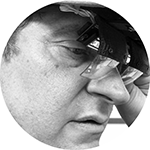Spam Blocked
Keynote: 35 Years of VR (David A Smith)
Sunday, June 25th, 2017
10:00am-10:55am
CR1D1-17(Room 201)
CONFERENCE OR MULTIPASS REQUIRED FOR ADMISSION
10:00am-10:55am
CR1D1-17(Room 201)
CONFERENCE OR MULTIPASS REQUIRED FOR ADMISSION
35 Years of VR
We humans are defined more by how we communicate than anything else.
Head wearable displays – once they are good enough – will transform the nature of how humans work, collaborate, communicate and even think. These wearable systems won’t just augment reality, they will augment the human being – providing new super powers that will be fundamentally transformative in what we are. This will be a true fusion of the creativity and romance of the human condition with the powerful information processing. visualisation and networking of the machine. This will, in turn, enable an augmented conversation where the users of the system are able to communicate and explore complex new ideas with each other. The machine will be in service to enabling and ennobling humans and humanity to collaborate and achieve a higher plane of existence as individuals and as a species.
We have started down the path toward developing and deploying such a system, but for this vision to itself become a reality requires that we create a platform that in turn allows us to develop an even better system from within it. The device that we will create will not just replace the phone and game systems, but it will be a powerful, wearable yet inexpensive workstation that enables anyone in the world to participate in helping to define and create our next future. Our goal should be to create a system that, as Alan Kay has said before, is good enough to criticise.
The path to achieving this vision requires a number of technical advances – some that we are on track for today, and some that will require additional effort. This includes:
- A new kind of operating system designed to be collaborative from the ground up and at every level. This should be accessible by children and adults, yet still allow the expert to develop more complex applications.
- An ability to design software and hardware from within the system itself. It will be a programmer and design workstation where the display is as big as the world.
rethinking the user experience that leverages these new capabilities – focussing on amplifying the intention of the user. Our goal is to dynamically convert the user’s ideas into reality. The interface should be almost invisible – the user thinks something and it appears and acts. - Hardware needs to be lightweight and nearly invisible. It should look like a regular pair of glasses or contact lenses, but must have a very wide field of view, must be in focus everywhere, must have a very high resolution and frame rate,
- Eye tracking needs to be a fundamental part of such a system. This provides both additional user control (look at an object to control it), but also allows us to utilize foveal rendering which can increase the rendering performance and complexity of the data we work with by two orders of magnitude.
- Other devices must enhance the user’s intention but minimise effort. Two great examples of this are the mouse, where the user need move it a few inches and the action is amplified into feet and the Daydream controller that requires small motions from the user but allows him to control worlds
My presentation will focus on the history of how we arrived where we are today, why we need such a system, what the challenges are to creating it and the path forward for making it a reality.

David A Smith | CEO Vision
Smith is a computer scientist and entrepreneur who has focused on interactive 3D and using 3D as a basis for new user environments and entertainment for over thirty five years. His specialty is system design and advanced user interfaces. He is a pioneer in 3D graphics, robotics, telepresence, artificial intelligence and augmented reality (AR). He creates world-class teams and ships impossible products. He built his first VR head wearable in 1982, using it as part of a telepresence platform used to remotely control a PUMA 560 robot arm.
Smith is the CEO and Founder of Wearality Corporation. Wearality manufactures and markets wide field of view lenses for VR that Smith invented while he was Chief Innovation Officer and Senior Fellow at Lockheed Martin MST. At Lockheed Martin he was focused on next generation human-centric computing and collaboration platforms as well as hardware for VR. Before joining Lockheed Martin, Smith was the chief architect of the Croquet Project, an open source virtual world collaboration platform where he worked with Alan Kay (Turing Award winner). He was later CTO and co-founder of Teleplace, Inc. providing a collaboration platform developed specifically for enterprises based on Croquet.
In 1987, Smith created The Colony, the very first real-time 3D adventure game/shooter and the precursor to today’s first-person shooters. The game was developed for the Apple Macintosh and won the “Best Adventure Game of the Year” award from MacWorld Magazine. Smith founded Virtus Corporation in 1990 and developed Virtus Walkthrough, the first real-time 3D design application for personal computers which won the very first “Breakthrough Product of the Year” from MacUser magazine. Smith also co-founded Red Storm Entertainment with author Tom Clancy and came up with the idea for the Rainbow Six computer game.
